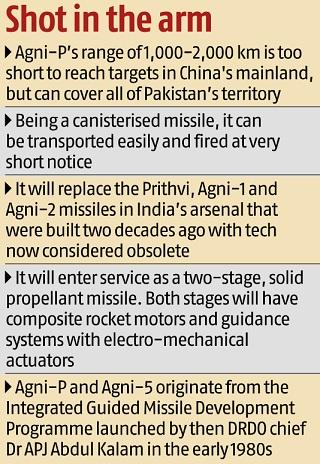Agni-P (Prime) | 29 Jun 2021
Why in News
Recently, a new generation nuclear capable ballistic missile Agni-P (Prime) was successfully test-fired by the Defence Research and Development Organisation (DRDO) from Dr. APJ Abdul Kalam island off the coast of Odisha, Balasore.
Key Points
 Agni-P is a new generation advanced variant of the Agni class (under IGMDP - Integrated Guided Missile Development Program).
Agni-P is a new generation advanced variant of the Agni class (under IGMDP - Integrated Guided Missile Development Program).- It is a canisterised missile with range capability between 1,000 and 2,000 km.
- Canisterisation of missiles reduces the time required to launch the missile while improving its storage and mobility.
- Many advanced technologies including composites, propulsion systems, innovative guidance and control mechanisms and state-of-the-art navigation systems have been introduced. The Agni-P missile would further strengthen India's credible deterrence capabilities.
- In comparison to other Agni class missiles, Agni-P has improved parameters including manoeuvring and accuracy.
- Agni Class of Missiles:
- They are the mainstay of India’s nuclear launch capability.
- Range of other Agni Missiles:
- Agni I: Range of 700-800 km.
- Agni II: Range more than 2000 km.
- Agni III: Range of more than 2,500 Km
- Agni IV: Range is more than 3,500 km and can fire from a road mobile launcher.
- Agni-V: The longest of the Agni series, an Inter-Continental Ballistic Missile (ICBM) with a range of over 5,000 km.
IGMDP (Integrated Guided Missile Development Program)
- It was conceived by Dr. A.P.J. Abdul Kalam to enable India attain self-sufficiency in the field of missile technology. It was approved by the Government of India in 1983 and completed in March 2012.
- The 5 missiles (P-A-T-N-A) developed under this program are:
- Prithvi: Short range surface to surface ballistic missile.
- Agni: Ballistic missiles with different ranges, i.e. Agni (1,2,3,4,5)
- Trishul: Short range low level surface to air missile.
- Nag: 3rd generation anti-tank missile.
- Akash: Medium range surface to air missile.
Canister Based Launch System
- Canister based launch system- serves as a container for transportation; a housing during storage aboard a vessel; provides operational flexibility.
- A canister launch system can be either hot launch, where the missile ignites in the cell, or cold launch, where the missile is expelled by gas produced by a gas generator which is not part of the missile itself, and then the missile ignites.
- Cold launch is safer than hot launch as the ejection system will eject the missile by itself even if there is a missile failure. In case of Agni V, it will be a cold launch.
- In case of hot launches, the problem is the heat produced by the missile at the time of launch. The hot launch is better for small missiles as the ejection part itself will be done by using the missile's own engine.
- Nuclear Triad:
- Nuclear triad, a three-sided military-force structure consisting of land-launched nuclear missiles, nuclear-missile-armed submarines, and strategic aircraft (e.g. Rafale, Brahmos) with nuclear bombs and missiles.
- DRDO had in January 2020 successfully test-fired a 3,500-km range submarine-launched ballistic missile, K-4, from a submerged pontoon off the Visakhapatnam coast.
- Once inducted, these missiles will be the mainstay of the Arihant class of indigenous ballistic missile nuclear submarines (SSBN) and will give India the stand-off capability to launch nuclear weapons submerged in Indian waters.
- INS Arihant, the only SSBN in service, is armed with K-15 missiles with a range of 750 km.
- In the past few years, India has been able to complete its nuclear triad. This is especially important given India’s No-First-Use policy while reserving the right of massive retaliation if struck with nuclear weapons first.
